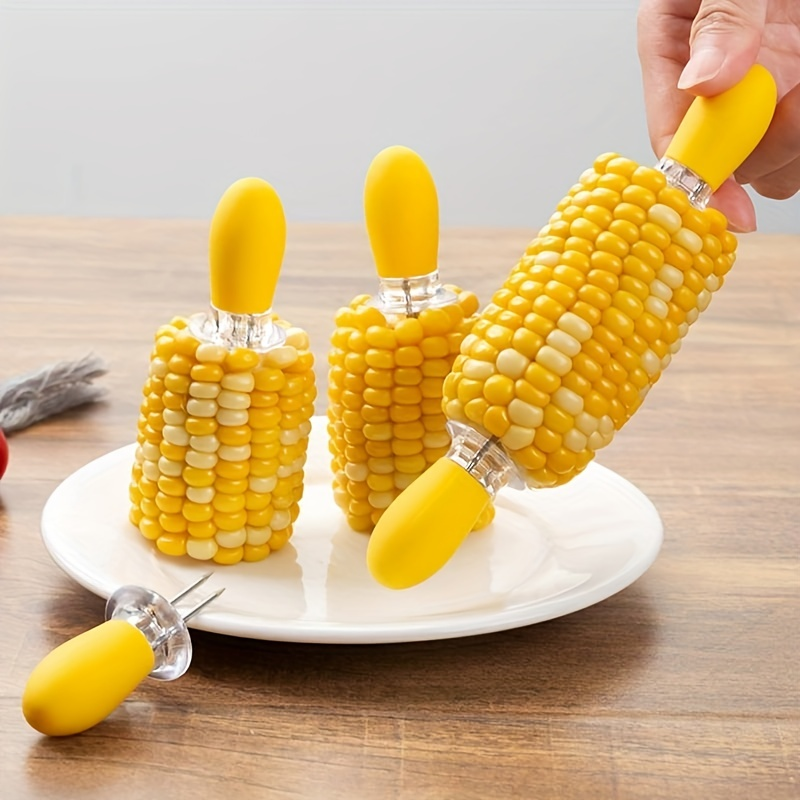Items in yellow that have great significance for our cherished memories of the past
Corn on the cob is a beloved summer treat enjoyed worldwide, and if you’ve ever dug into a steaming cob, you know just how helpful those little corn holders can be. These nifty tools allow us to savor the delicious corn kernels without burning our fingers or losing grip. But have you ever wondered about the history behind these essential utensils? Corn on the cob holders, also known as corn skewers, have a rich history dating back to the early 19th century, evolving in design and functionality over time. Let’s explore their origins, how they’ve changed, and why they continue to be indispensable in kitchens and at barbecues everywhere.
Early Beginnings: Corn on the Cob Holders in the 19th Century

In the early 1800s, corn became a staple food in many parts of the world, especially in North America. As the popularity of corn on the cob grew, so did the need for a practical way to eat it. The early corn holders, or skewers, were typically handcrafted from materials like wood or bone. These simple designs served one primary purpose: to provide a firm grip on the cob and prevent burns or greasy fingers.
Back then, corn on the cob was often eaten outdoors, cooked over open flames during family gatherings or community events. People soon realized they needed something to make eating this slippery, buttery treat easier and more comfortable. This necessity led to the invention of the corn skewer, an early version of today’s holders, which consisted of two prongs designed to pierce each end of the cob.
The Evolution of Corn on the Cob Holder Designs
Over the years, corn holders have undergone numerous design changes, driven by both functionality and aesthetics. Early versions were rather plain and focused on utility, often consisting of two pointed prongs made from wood or metal, which could be inserted into the ends of the corn cob. This design allowed for a secure grip, preventing the cob from slipping as diners enjoyed their meal.
As time passed and culinary tools advanced, so did the design of corn holders. By the mid-20th century, manufacturers began experimenting with materials and styles to improve durability and comfort. Corn holders were no longer just practical; they started to incorporate decorative elements and became an attractive addition to the dinner table. Handles made of bakelite, stainless steel, and plastic soon became popular, and ergonomic shapes were introduced to enhance grip and comfort.
Practical Innovations in Modern Corn Holders
Today, corn on the cob holders come in countless designs, from basic prongs to more elaborate, ergonomic models. Many modern versions feature heat-resistant handles, which add safety when corn is served hot. Some even come with fun, themed designs, such as handles shaped like corn kernels, animals, or summer-themed items, adding a playful touch to outdoor barbecues and family picnics.
Another significant development has been the addition of features like silicone grips for added comfort and even reusable holders made from eco-friendly materials. These advancements reflect our evolving culinary needs, demonstrating how a simple tool can adapt to changing times.
Corn Holders and Their Cultural Significance
Corn on the cob holders hold more than just corn—they also hold cultural value. In areas where corn is a dietary staple, these small tools represent family gatherings, summer cookouts, and shared meals. Corn has been a central part of culinary traditions in various cultures for centuries, and the experience of eating corn on the cob is often associated with a sense of community and celebration.

Throughout the 20th century, corn on the cob holders became a staple of American cookouts and picnics, especially during the summer months. They symbolize togetherness and simplicity, as families and friends gather around outdoor grills and picnic tables to enjoy grilled corn, burgers, and hot dogs. In some families, vintage corn holders are even passed down from generation to generation, cherished for their nostalgic value.
Craftsmanship in Vintage Corn Holders
Older corn on the cob holders, particularly those from the mid-1900s, are often admired for their craftsmanship. These vintage holders were made to last, with solid metal prongs and durable handles crafted from bakelite or early plastics. Many collectors seek out vintage corn holders not only for their functionality but also for the sense of tradition and history they carry.

Modern-Day Use: An Indispensable Tool for Corn Lovers
Despite advancements in kitchen tools, corn on the cob holders remain as popular as ever. Their simple yet effective design makes them a practical choice for enjoying fresh, buttery corn without the mess. These holders are commonly used at home, at barbecues, and during outdoor gatherings, as they allow everyone to savor their corn without worrying about sticky fingers or burnt skin.
Today’s corn holders are designed with convenience in mind. Many sets come with handy storage cases, making them easy to keep track of, even when not in use. Additionally, dishwasher-safe materials make cleanup a breeze, ensuring that corn on the cob holders are ready for the next family barbecue.
Popular Modern Designs and Features
The corn holder market has expanded to offer a wide variety of designs, ranging from classic to contemporary. Here are some features that make modern corn on the cob holders even more convenient and enjoyable to use:

- Heat-Resistant Handles: These handles allow for a firm, cool grip, even when the corn is piping hot.
- Themed Designs: From corn kernels to cute animal shapes, themed holders add a fun element to the dining experience.
- Stainless Steel Prongs: Stainless steel provides durability and rust resistance, making these holders long-lasting and easy to maintain.
- Eco-Friendly Options: For those looking to minimize their environmental footprint, eco-friendly corn holders made from bamboo or other sustainable materials are now available.
The Timeless Appeal of Corn on the Cob Holders
Corn on the cob holders may have humble origins, but their enduring popularity speaks to their utility and charm. Whether they’re part of a traditional family cookout or a fancy backyard barbecue, these simple tools continue to make eating corn on the cob easier and more enjoyable. They bring a touch of nostalgia to any gathering, reminding us of shared meals, warm summer days, and the simple pleasure of fresh, sweet corn.

In a world where culinary trends come and go, the corn on the cob holder has proven itself a timeless tool. Its practical design and versatility have ensured its place in kitchens and picnic baskets for over a century, and as long as people enjoy corn on the cob, there will be a place for these classic skewers.
Conclusion: Celebrating the Legacy of Corn on the Cob Holders
The journey of the corn on the cob holder—from simple wooden skewers to today’s heat-resistant, decorative designs—reflects both innovation and tradition. These little tools have brought convenience to countless meals and continue to symbolize the joy of gathering around the table. Corn on the cob holders are a testament to the fact that even the simplest tools can have a big impact on our dining experiences, blending function with fun and a touch of nostalgia. So next time you enjoy a fresh cob of corn, take a moment to appreciate the role of these trusty little holders in bringing a bit of comfort and delight to your meal.




